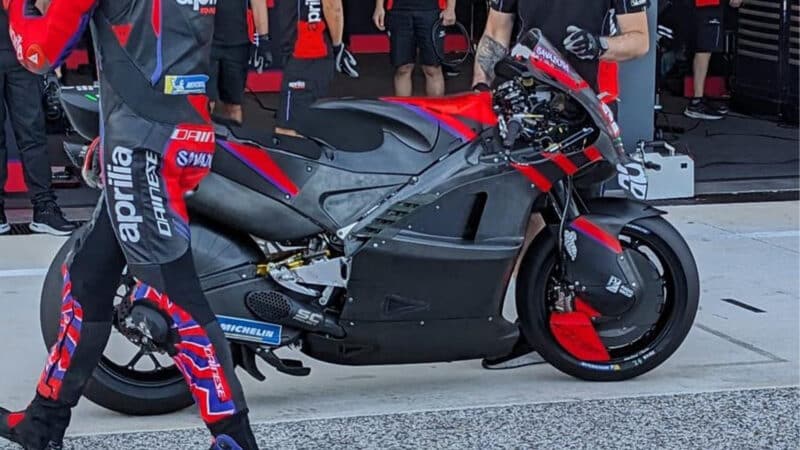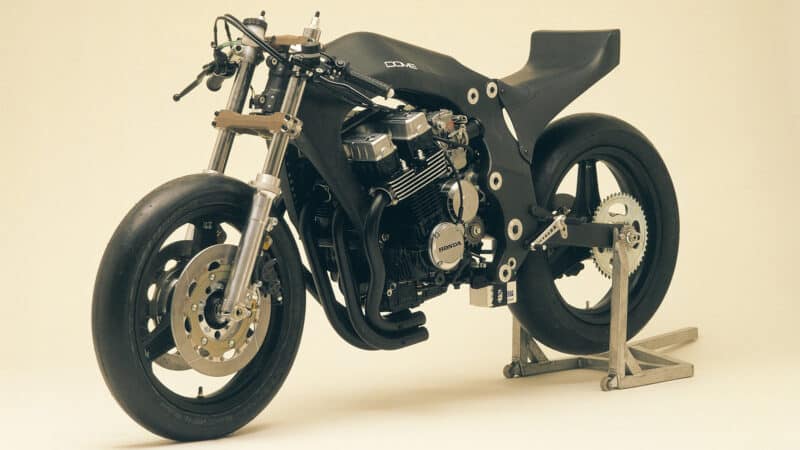Aprilia may race carbon-fibre RS-GP next week at Red Bull Ring!
Aprilia’s other issue was poor starts, which exacerbates the front-tyre problem because riders get stuck in the pack, surrounded by a few boiling-hot 300-horsepower MotoGP bikes.
“Our main weak point is the start,” said chief engineer Romano Albesiano a couple of months ago. “We’re not worse than last year but clearly our competitors have improved, especially KTM, who have done some special stuff in this area, which is working incredibly well.”
Silverstone suggested that Aprilia has definitely improved its starts, with a new clutch and revised launch control.
Aero upgrades at Silverstone – a modified fairing to increase rear downforce in the corners and revised front-wheel fairings to cut through the air better – also made a difference.
Of course, Silverstone’s flowing curves suit the fine-handling RS-GP. The next challenge is stop-and-go circuits, like the Red Bull Ring.
Ducati has a major advantage at this kind of track, because the Desmosedici puts much more torque to the ground than other bikes when exiting slow corners, and doesn’t pitch forward so much during braking, which allow riders to use lots of rear brake to stop the bike quicker.

Savadori and the carbon-fibre RS-GP during last week’s exploratory tests at Misano
So these are the areas where Aprilia needs to work. And perhaps its brand-new carbon-fibre chassis could help.
Test rider Lorenzo Savador’s initial feedback during last week’s Misano tests was positive, so the factory is now running ongoing evaluations before making its decision about the Red Bull Ring.
Racing the new chassis as soon as possible makes all kinds of sense, because there’s nowhere better to evaluate new solutions than in the white heat of a racing weekend.
But why a carbon-fibre chassis? MotoGP’s minimum weight limit is set very high – at 158 kilos – to discourage expensive weight-saving developments. World Superbike’s minimum weight is 168 kilos; thus a cutting-edge prototype gets to weigh just ten kilos less than a road bike. In 1990, the 500cc/MotoGP minimum weight was 115 kilos, against around 160 kilos in WSB!
So, what’s the point of running a lighter chassis in MotoGP if the minimum weight is so high? Because if you save weight in one area you can spend it elsewhere, where it may improve performance.
Aprilia knows that one of its biggest disadvantages against the Ducati is the Desmosedici’s lack of pitching on the brakes, which allows riders to use the huge grip of Michelin’s rear slick to stop super-quick, which also takes load (and therefore risk) away from the not-so-good front slick.
Perhaps rebalancing the RS-GP with the weight saved by the carbon-fibre chassis will help engineers improve the bike’s braking balance? And there are many other potential benefits.

The carbon-fibre Dome Racing Black Buffalo, powered by a Honda CBX engine, raced at the 1985 Suzuka 8 Hours
Dome Racing
Carbon-fibre allows you to adjust the…
Read More: Aprilia may race carbon-fibre RS-GP next week at Red Bull Ring! 2023-08-09 08:54:58
